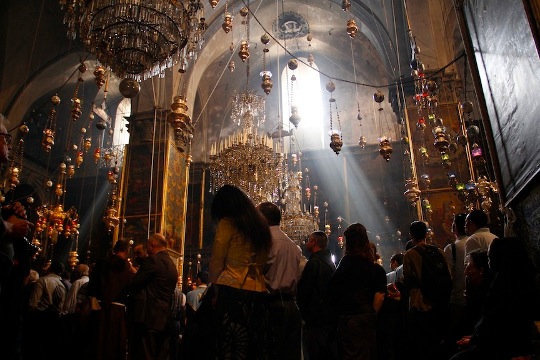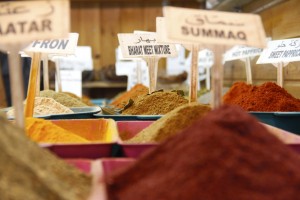When the Rockets Come Down

It has been a confusing time for me, here in Jerusalem. There is a sense of helplessness among those I live and work with, knowing there is nothing we can do. Hamas and Israel will do battle to the detriment of the Palestinian people. There is no intervention (that I know of) that will bring this to a rapid end.
And yet, in the Old City (where I walked to and from late this afternoon), life goes on much as usual. The Palestinian Christians or Muslims who do not observe the Islamic day of rest continue to promote their services and wares, kids run along side cars hoping to sell silver Mylar balloons with bright pink letters, “I
While the escalation of events is worse than most of the skirmishes in the past few years, there is no immediate sense of danger nor fear here in Jerusalem, even as we are told (BBC) a rocket landed shy of here a little over an hour ago. I was standing across from the North East corner of the Arab quarter when the air raid siren went off. I stopped, grabbed my camera (just in case) and waited. It didn’t last long, a few minutes total. No one seemed to notice or care, and so I continued across the Kidron Valley and up the Mount of Olives. There were fireworks nearby for another Palestinian wedding (there are many) and the usual buses and cars, but I failed to hear anything else.
I had walked through the Islamic grave yard, around the southern wall and past the archaeological site. I passed through the metal detectors, my camera backpack of more interest than the coins in my pocket or cell phone, the guard asking where he could find one like mine. I spent some time at the Western Wall, watching, learning, wondering. I squeezed through a soccer match intensified by the narrow corridor and stubborn school aged girls who refused to make way for the boys and their game.
I arrived to the Church of the Redeemer to talk to Lukas, a German volunteer. Yet unsettled and wanting to make sense of what was happening just ninety kilometers away, I continued my walk down Muristan Street. I came across Fatir, a Palestinian Muslim whom I have come to admire. He was to the front of his pizza shop, not working but just sitting, observing. He shook my hand and put his arm around my shoulder as I sat by his side, he on a plastic lawn chair and I a bit lower, on a limestone block which formed the kickstone beneath his counter.
He said, “My friend. How are you?”
“Sad. Confused,” I responded.
He didn’t say anything, and so I continued, “Is it like this often? You seem to not be concerned with what is happening.”
“Yes, it has been like this since they took our land more than fifty years ago. There is nothing we can do.”
“How do do you do it? How do you remain this way, warm to everyone who comes through.”
He smiled and rose, saying, “Do you want some tea? Yes. I will make you some tea. Here. Stay here,” placing his hand on my shoulder and pressing lightly down.
Fatir is a handsome man, with short, cleanly trimmed black hair and beard. He has the face of a professor of history, a man who has confidence beyond worldly means. He always carries a subtle smile which says he knows something I do not, that everything will be ok.
The first time I met him he said, “Do you want a pizza?” to which I responded, “Yes, but just one slice please, I am not very hungry.”
“I am sorry. I do not sell just one slice. You should take the whole pie.”
“It is too much.”
“It is good to eat. You can save the extra for later.”
“Quadesh?” I asked. (“How much?”)
“Ashrine shekels,” he responded, but then after a pause, “but today, as I am not so busy and would rather cook than clean, half price and you can save half the pizza for tomorrow. But you must stay and talk to me.”
And so I did. And we talked while I ate. Both the conversation and fired pizza were splendid.
A few weeks ago I stopped in with a new friend (we had met an hour prior at a funeral), an Israeli architect whose friend, a Catholic Priest, had asked us to fetch a beer for him to consume during the service (which he did). While we waited for pizza (as practicing Muslims do not serve alcohol, we went to another shop), Fatir granted us the most animated oral narrative of the history of Mecca I had ever heard. In the end, he tied Islam, Christianity, and Judaism together, reminding us of the common origin through Abraham and his wives. There we were, a Muslim, a Jew, and myself of Christian foundation telling stories over pizza in Jerusalem. No where else in the world does this happen so readily … and just a few weeks later, the conversation transition to one of rockets and death by remote control.
Fatir returned with today’s newspaper. He sat beside me again, and opened to a full page spread. A dozen photos showed bodies buried in rubble, mud, and one, quite unrecognizable. All in Gaza at the fall of Israeli rockets. “Look. Our people, they are afraid, running, crying, wanting the bombs to stop.” On the next page, he showed me photos of the apartment in Tel Aviv whose outer wall was blown away by a rocket from Gaza. “Look, the Israeli soldiers, they are afraid too, lying on the ground covering their heads, the Israeli people killed.” He closed the paper and folded it in his lap. “We are all human. We are the same. But this will continue because everyone is afraid of how we are different. Hamas does not represent us, the Palestinians. They are doing this for themselves. It is very, very sad.”
I sat there with him for an hour, almost comforted by the smoke from his cigarette as its smell intermixed with the sound of his calm voice. After some time, he asked me, “How do you think it will end?” I took a deep breath, shook my head and shared with him something I had been thinking about for a few weeks time, “When I was a boy, in school, we were told the Europeans, the Spanish, the Portuguese, the French and English came to a land relatively empty and free for the taking. We were taught that at first, there was peace with those few people who were already there, but then they became angry and started to attack the settlers. I grew up with these images, these stories, believing they were true. It was only many years later, as I read and learned about the real history of the United States that I have come to see the truth.”
Fatir stood and ran into his shop for a moment, then returned, “Continue.”
“There were an estimated twenty million Native Americans in what is now Canada and the U.S. Nineteen million were killed or died from disease in roughly two hundred years. While far less populated than Europe at that time, it was by no means an empty continent. In Central and South America, the story was the same.”
Fatir said, “Wait, wait. Shuay, shuay. Tell me again,” and he put his hand on my knee.
“The ones who win Fatir, they rewrite history. My fear is that some day, maybe in one hundred years, the Palestinians will be a nearly forgotten people here, in this land with a four thousand year Palestinian history. No, it has not been that of the Palestinians alone, for many nations have come and gone. More than twenty in all—” at which point Fatir nodded his head and as though we had practiced a dozen times before, we together listed “Caananites, Hitites, Philistines, Egyptians, Hebrews, Greeks, Romans, Turks, and the English too.” He smiled, pleased, I believe, I know some of the history. “That’s right. Nearly thirty nations have claimed ownership of this narrow strip of land. Some hostile take-overs, some gradual migration and merger of people,” I added.
“Yes. I see your point. I had not thought of this before. We are losing our land. And maybe we will lose our history too, as we scatter, living now in so many places: Jordan, Syria, Kuwait, and Egypt too.” We sat there for a while longer, and I asked about his wife and children. Three sons. Three daughters, the oldest of which is “quite clever” receiving 99% in Mathematics at Hebrew University.
It was growing dark and I had yet to walk home. I said I needed to go and without hesitation he took my tea cup from my hand, placed his other hand on my head and ruffled my hair, saying, “Come again. You are always welcome here.”
“Shokron my friend, w’masaleme.”
“Inshallah.”






















































